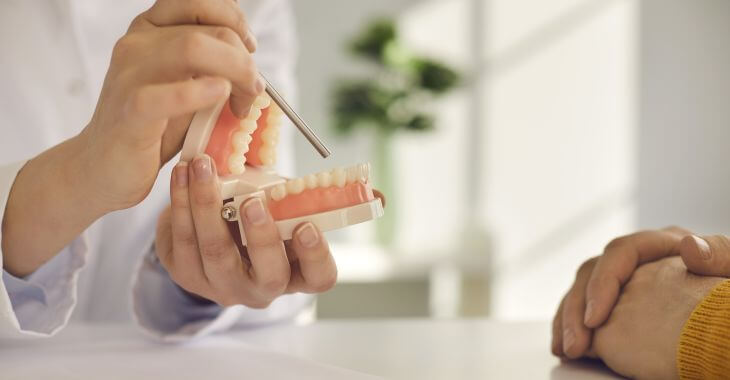Temporomandibular Joint Disorder Symptoms Checklist: Do You Have TMJ?

Jaw pain, headaches, and facial tension can be more than just stress—they may signal a temporomandibular joint disorder (TMJ or TMD). Understanding the warning signs early is key to effective treatment and lasting relief.
The following temporomandibular joint disorder symptoms checklist will help you recognize potential issues and know when it’s time to seek professional care.
What Is Temporomandibular Joint Disorder?
The temporomandibular joint (TMJ) connects your jawbone to your skull, allowing you to speak, chew, and yawn comfortably. When this joint becomes misaligned, strained, or inflamed, it can lead to persistent pain and dysfunction known as TMJ disorder.
Common Causes of TMJ Disorder
TMJ disorders may develop gradually or suddenly. Common causes include:
- Chronic teeth clenching or grinding (bruxism)
- Jaw misalignment or dental bite problems
- Stress-related muscle tension
- Arthritis in the jaw joint
- Previous jaw injury or trauma
Even daily habits—like chewing gum or biting nails—can worsen jaw stress over time.
The Temporomandibular Joint Disorder Symptoms Checklist
Recognizing symptoms early can help prevent worsening discomfort. Use this temporomandibular joint disorder symptoms checklist to identify possible warning signs:
- Jaw pain or tenderness when opening or closing your mouth
- Clicking, popping, or grinding noises in the jaw joint
- Difficulty or pain while chewing
- Facial pain near the temples or ears
- Headaches or migraines related to jaw tension
- Limited movement or locking of the jaw
- Ear pain, ringing, or pressure without infection
- Swelling on one or both sides of the face
- Pain radiating to the neck, shoulders, or upper back
If several of these symptoms sound familiar, you may be experiencing TMJ disorder and should consult a dental or jaw specialist.
Secondary Symptoms Often Overlooked
TMJ disorders can also cause secondary symptoms that are easy to misdiagnose. These may include:
- Dizziness or lightheadedness
- Tooth sensitivity without cavities
- Fatigue from constant muscle tension
- Tingling in the face or jaw area
These less obvious issues are part of why TMJ disorders often go untreated for years.
Why Jaw Clenching Happens
Many people clench or grind their teeth—especially during sleep—without realizing it. This condition, known as bruxism, is one of the most common contributors to TMJ pain.
If you’re wondering how to stop clenching teeth at night, begin by identifying triggers such as stress, caffeine, or poor posture. Simple awareness and relaxation before bed can help reduce unconscious jaw tension.
How to Stop Clenching Teeth at Night
Learning how to stop clenching teeth at night is essential for protecting your jaw and preventing further damage. Try these steps:
- Wear a custom night guard from your dentist to protect teeth.
- Reduce stress through meditation or relaxation exercises.
- Avoid caffeine or alcohol close to bedtime.
- Apply warm compresses before sleep to relax jaw muscles.
- Ensure proper neck and head support while sleeping.
Breaking this habit takes consistency, but even small lifestyle changes can significantly reduce pain and stiffness.
TMJ Exercises for Jaw Pain
Gentle stretching and strengthening routines can improve flexibility and relieve pressure. These TMJ exercises for jaw pain can be done at home daily:
- Relaxed Jaw Exercise: Rest your tongue gently on the roof of your mouth and slowly open and close your mouth.
- Resisted Opening: Place your thumb under your chin and gently push downward while trying to open your mouth.
- Side-to-Side Motion: Move your jaw slowly from side to side to improve the range of motion.
- Forward Jaw Movement: Move your lower jaw forward so your bottom teeth extend past your top teeth.
Always perform TMJ exercises slowly, stopping if pain increases. Consistency is key to restoring balance and reducing inflammation.
When to Seek Professional Help
If at-home care and TMJ exercises for jaw pain don’t resolve your discomfort, it’s time to consult a dentist who is a TMJ specialist. Persistent or worsening symptoms may require professional treatments, including:
- Custom mouthguards or bite splints
- Physical therapy or chiropractic alignment
- Trigger-point or muscle relaxation therapy
- Orthodontic adjustments
- Botox injections to relax overactive jaw muscles
Early treatment can prevent joint deterioration and restore comfortable movement.
How Professionals Diagnose TMJ Disorders
A qualified dentist or TMJ specialist will evaluate your jaw alignment, bite, and muscle tension. Diagnostic imaging such as X-rays, CT scans, or MRIs may also be used to assess joint structure.
This comprehensive approach ensures that treatment targets the root cause—not just the symptoms—of your pain.
Lifestyle Tips for Managing TMJ Pain
TMJ discomfort can flare up with stress or repetitive jaw activity. Use these daily habits to reduce tension:
- Eat soft foods during flare-ups
- Avoid excessive chewing or wide yawning
- Maintain good posture to relieve neck and jaw strain
- Schedule regular stress-reducing activities
Small adjustments make a big difference in long-term comfort.
The Path to Relief
A clear temporomandibular joint disorder symptoms checklist helps patients recognize early warning signs and take control of their condition. With proper diagnosis, treatment, and consistent TMJ exercises for jaw pain, most individuals can avoid surgery and enjoy a pain-free jaw again.

If you’re struggling with how to stop clenching teeth at night, professional guidance can help identify triggers, customize therapies, and protect your oral health.
TMJ disorder may be complex, but relief is possible—and lasting comfort starts with awareness and early action, including a visit to your local dentist who specializes in TMJ disorders.
The information provided on this website, including text, graphics, images, and other materials, is intended solely for informational purposes and should not be used as a substitute for professional medical advice, diagnosis, or treatment.




)